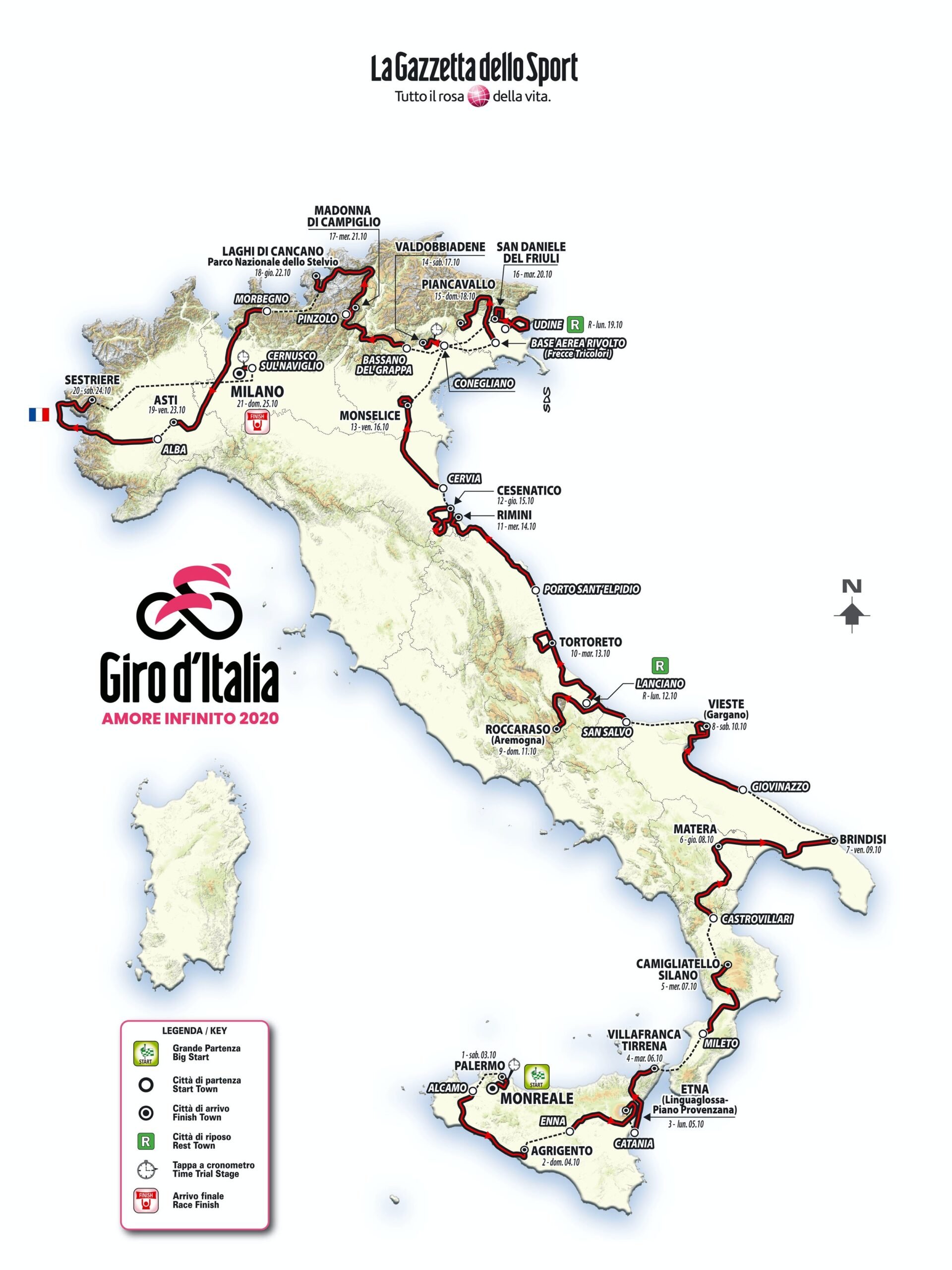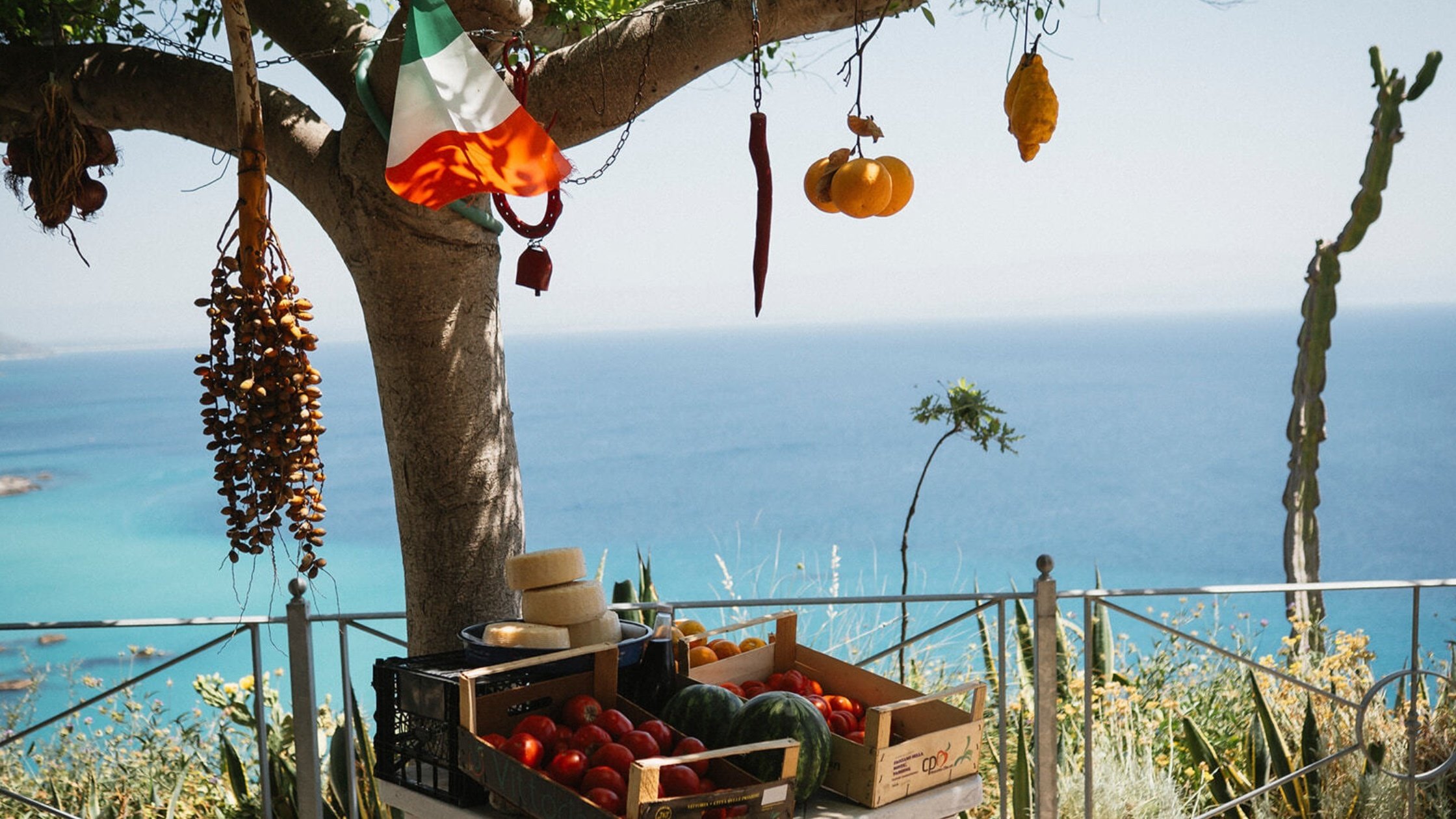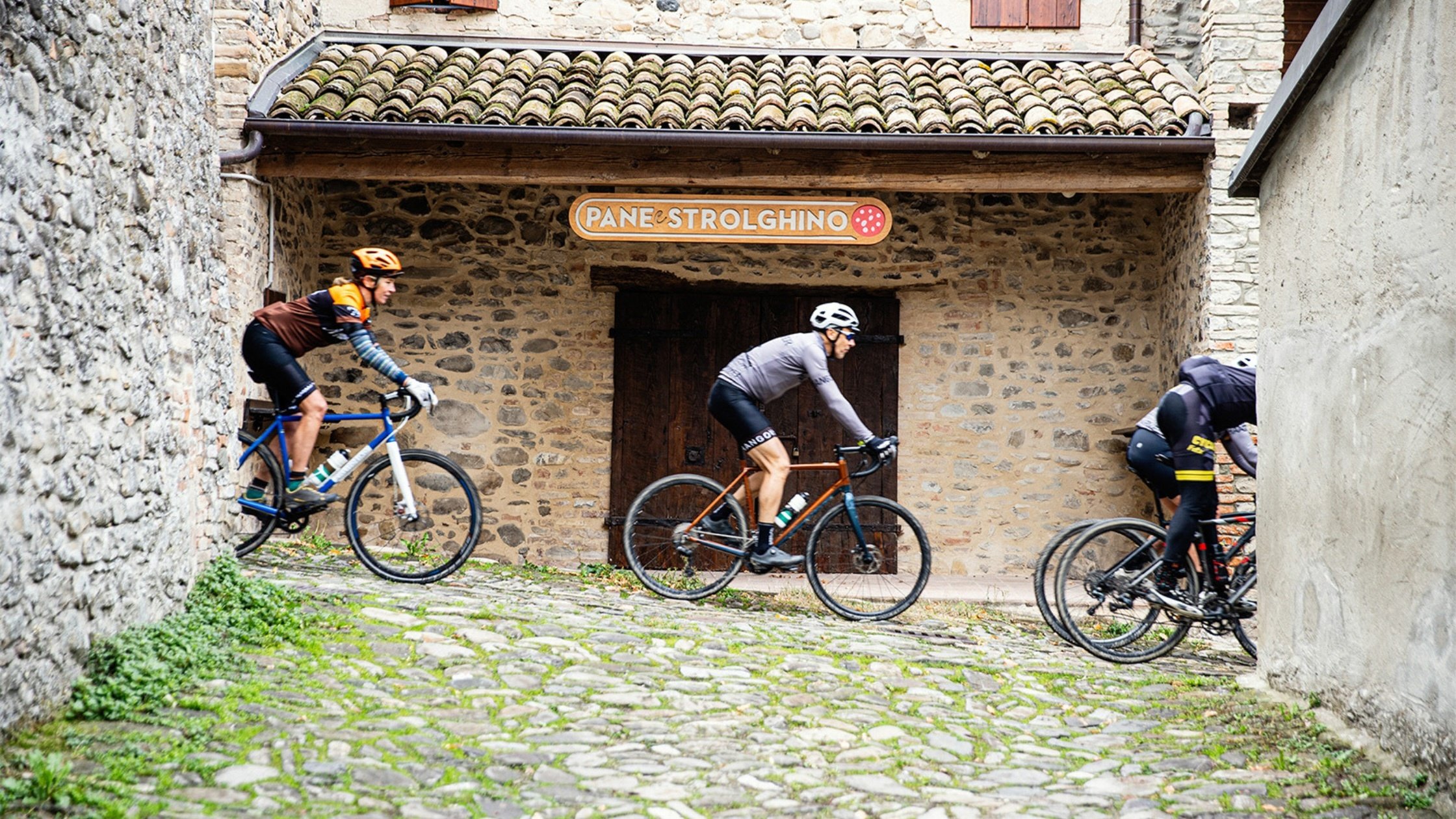The Giro d’Italia has witnessed Italy change geographically, politically, and socioeconomically since its inception in 1907. All Italians and cycling fans around the world discover (and re-discover) Italy year after year thanks to the Giro. It’s always been that way.
The 2020 Giro was be a memorable one for sure, and we are looking back at the route to highlight some of our favorite places through which the race passed and that we also visit on our tours.
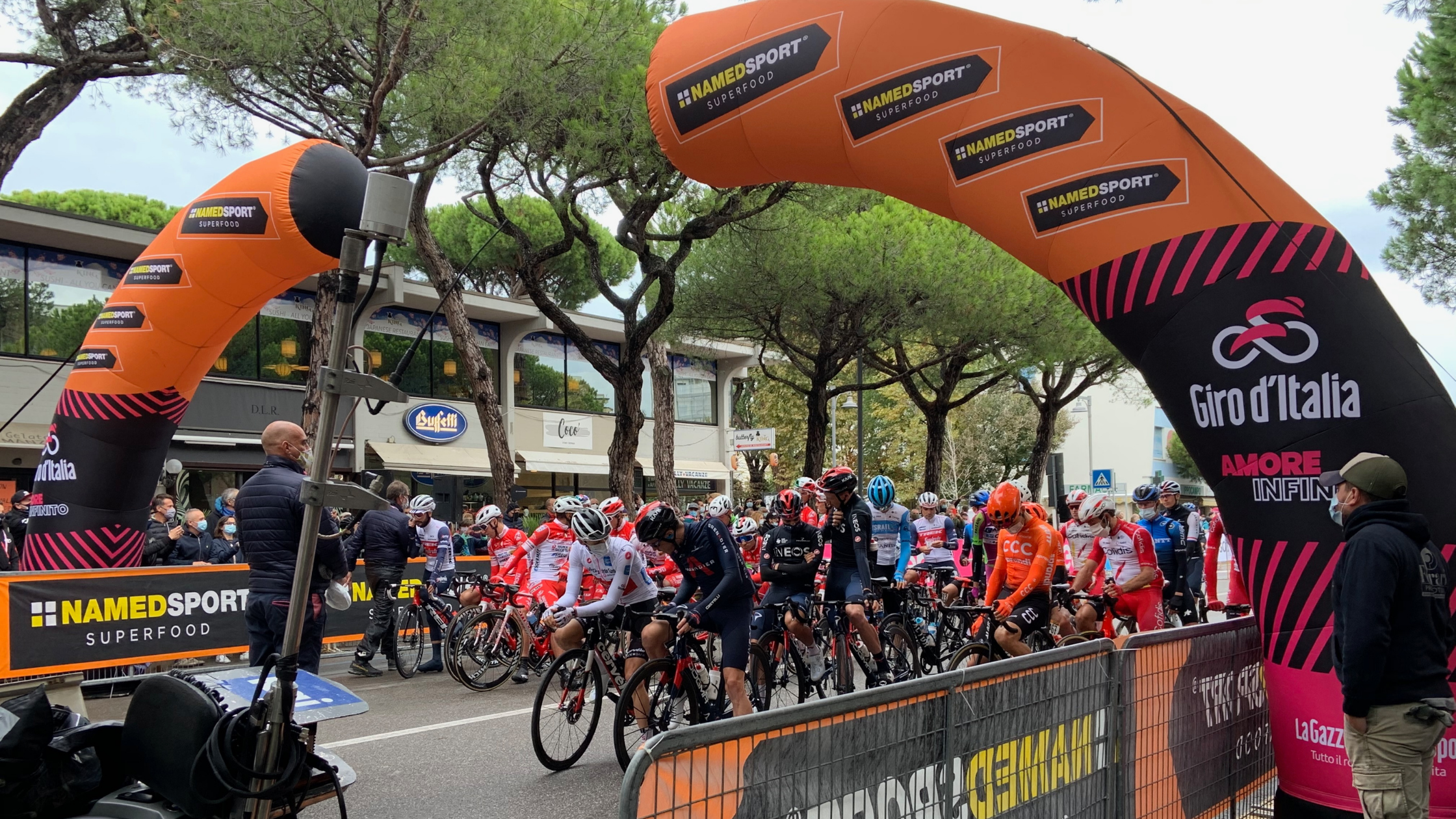
First through the radio waves and newspapers, then through television, and now through multi-media broadcasting we learn and dream of those destinations crossed by the riders and the Giro caravan.
While watching the Giro d’Italia stage after stage (in 2020 I have spare time and a flexible schedule) and while reading the Spectator Guide, I could recognize many places that we visit on Tourissimo tours. Perhaps, you have been on our tours that cross the same places and you were pleased to recognized familiar towns and roads.
Here are some of the 27 places from the 2020 Giro d’Italia where Tourissimo travels to and plans to return. I skim through them and I link Tourissimo's tours that correspond to those areas. We'll list the rest of them next week.
Stage 1 – Palermo and Monreale (time trial)
Palermo, the capital of Sicily, has been a melting pot of cultures from Norman to Arab, from Greek to Spanish. Palermo boasts a complex historic legacy and a rich heritage of treasures.
The city hosts seven World Heritage monuments: the Royal Palace with the Palatine Chapel, the church of San Giovanni degli Eremiti, the cathedral, the church of Santa Maria dell’Ammiraglio, San Cataldo, the Zisa Palace and the Admiral’s Bridge. Major landmarks also include several Baroque churches and oratories, noble mansions, historic villas and seaside villages, along with the historic markets of Ballarò, Capo and Vucciria.
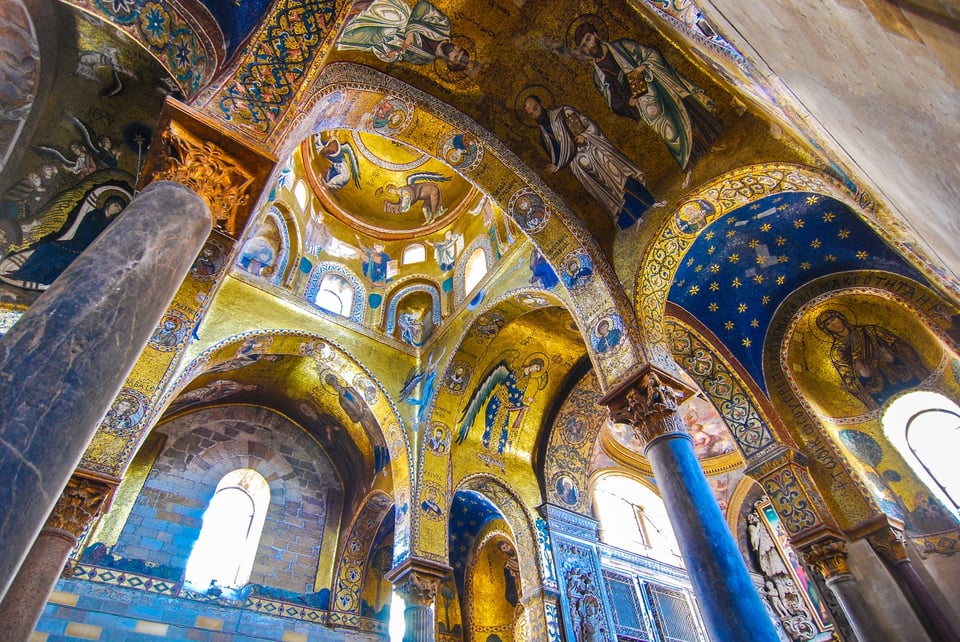
The stunning Palatine Chapel (Palermo)
Monreale (5 km from Palermo) is mostly known for its Cathedral (UNESCO site) and its masterpiece Byzantine mosaic decoration with gold background, which almost entirely covers its walls showing a compendium of stories from the Bible dominated by the gigantic Christ Pantocrator in the major apse.
Stage 2 - Sambuca di Sicilia, Menfi, Nuova Gibellina
Sambuca di Sicilia is a small center in the Sicilian province of Agrigento. Located between Menfi, Sciacca and the Archeological Park of Selinunte, Sambuca di Sicilia was very likely founded in the early Middle Ages by the Arab Emir Al-Chabut, who had his own castle built on the hill where the village lays today. There is no longer any trace of the glorious abode of Al-Chabut, yet that very spot is occupied by two of the village’s beauties: the terrazzo Belvedere, an amazing terrace overlooking Sambuca’s surroundings, and the village’s Chiesa Matrice (or Chiesa Madre). Not far, Lake Arancio is a beautiful site surrounded by vineyards.
Menfi is a small agricultural center sitting between Selinunte and Sciacca in Southwestern Sicily. Surrounded by rolling vine-covered hills that descend gently down to the to the dunes and white sandy beaches of the coast below, it has the humble charm of an authentic, working Sicilian town.
Menfi's ancient origins date back to the time of the Sicanian King Cocalo, who founded the town of Inycon and built a palace there, long before the first Greek settlers arrived in Sicily.
Gibellina is a small village in the Belice Valley. It was destroyed by the 1968 Belice earthquake.
The new city, Gibellina Nuova, was rebuilt some 11 kilometers (7 mi) distance from the old one. The new city was designed by some of the most prominent artists and architects in Italy, but was constructed in a modern fashion so that the parts of the new city bear little relation to one another or to the indigenous architecture of Sicily.
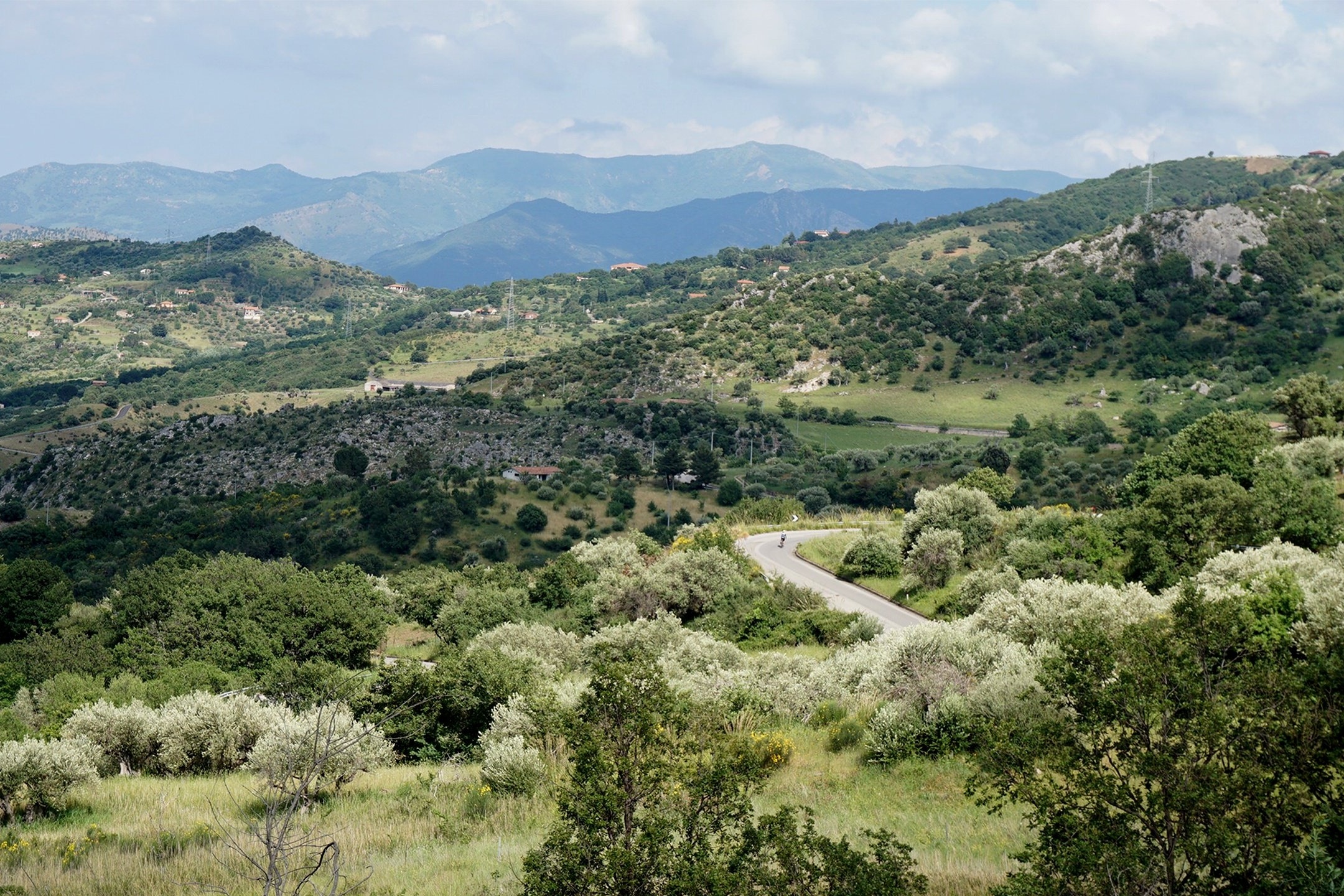
Sicani Mountains - Southwestern Sicily
Ruderi di Gibellina (as the ruins of the city are now referred to) remained just as it was after the earthquake, practically a ghost town. Artist Alberto Burri covered the entirety of the ruins in concrete, while preserving the streetscape.
Visit these sites on our Western Sicily Bike Tour.
Stage 3 - Etna, Zafferana Etnea
Etna, also known by Sicilians as ‘Mongibello’ (The Beautiful Mountain), is located on the east coast of Sicily, in the province of Catania. It is the highest volcano in Europe at more than 3,350 mt (11,000 feet). It erupts from the four main summit craters, and has an activity which is both effusive (with liquid magma flows) and explosive: not infrequently, it can "spit" dense columns of ash and gas visible even from space satellites, launching the rocks produced by its eruptions into the surrounding areas. For this reason the region is particularly fertile and a first-rate wine area.
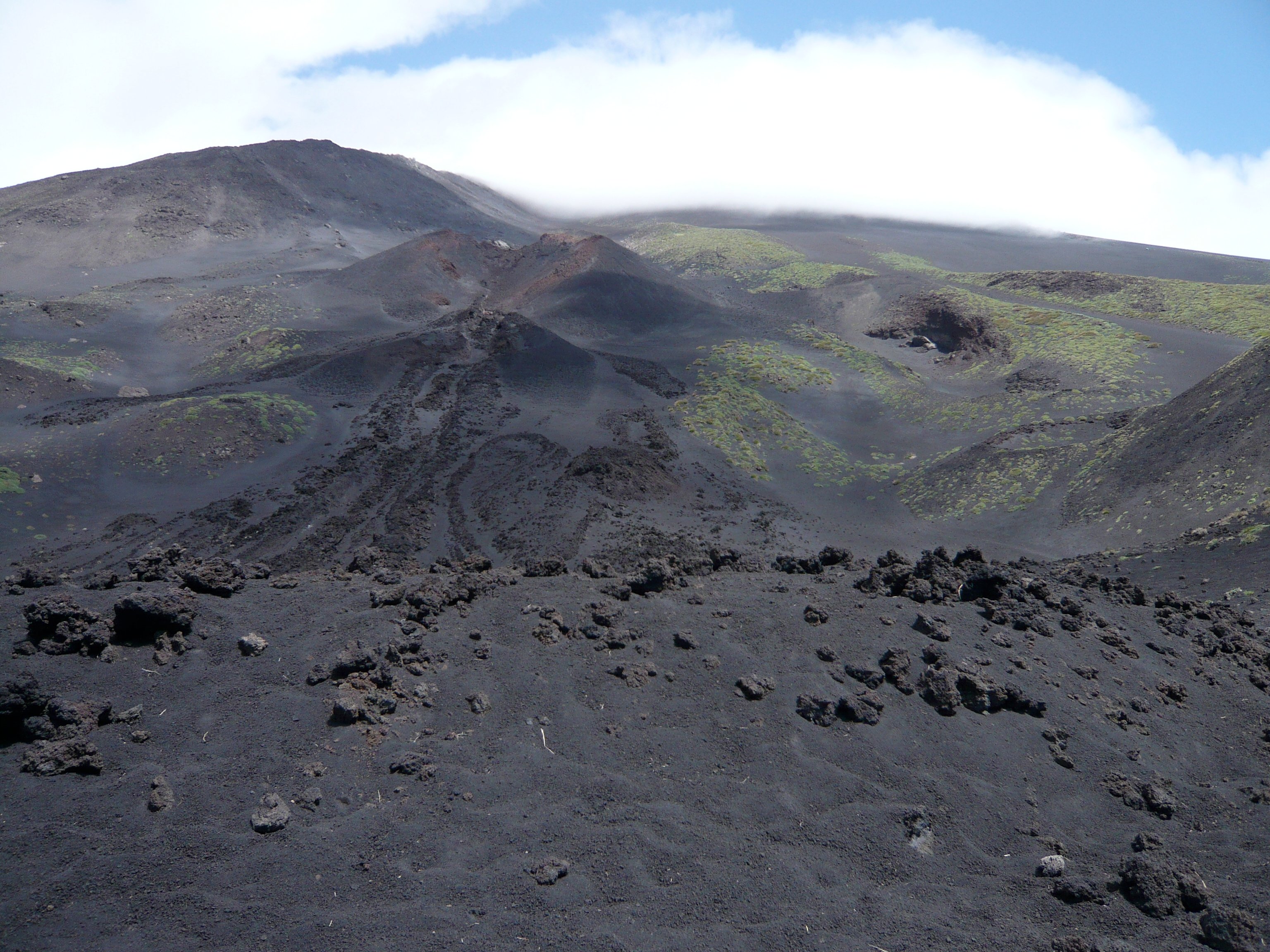
Mount Etna - the highest volcano in Europe
At about 500 meters above sea level, Zafferana Etnea provides a cooler climate during the oppressive heat of summer. Nestled between mountain and sea, it sits among the green hills that rise up to the heights of Mt. Etna but is just minutes to the Ionian Sea, as well. The town is the launching point for excursions up to the famous volcano, with roads and trails leading into the national park. The bronze doors of the cathedral depict a scene from the eruption of 1792 and religious votives are found scattered all over town, showing the town's respect for nature and supplication to the saints to preserve it.
Visit these sites on our Sicily East and Aeolean Islands Multisport Tour.
Official tourist sites:
Stage 6 – Matera
Touring Matera is like experiencing a forgotten past - you feel as though you are setting foot in a nativity scene when you visit this charming city in Basilicata. It’s no coincidence it’s referred to as the second Bethlehem, and was the setting for Mel Gibson’s movie The Passion of the Christ. Matera is the third-oldest continuously inhabited place on earth (about 9,000 years). In the 1950’s when the inhabitants who lived in the caves dug out of the mountain were forced to abandon those dwellings to settle in modern districts, no one could have ever imagined that those caves - the Sassi - would have become the symbol of a reborn city.
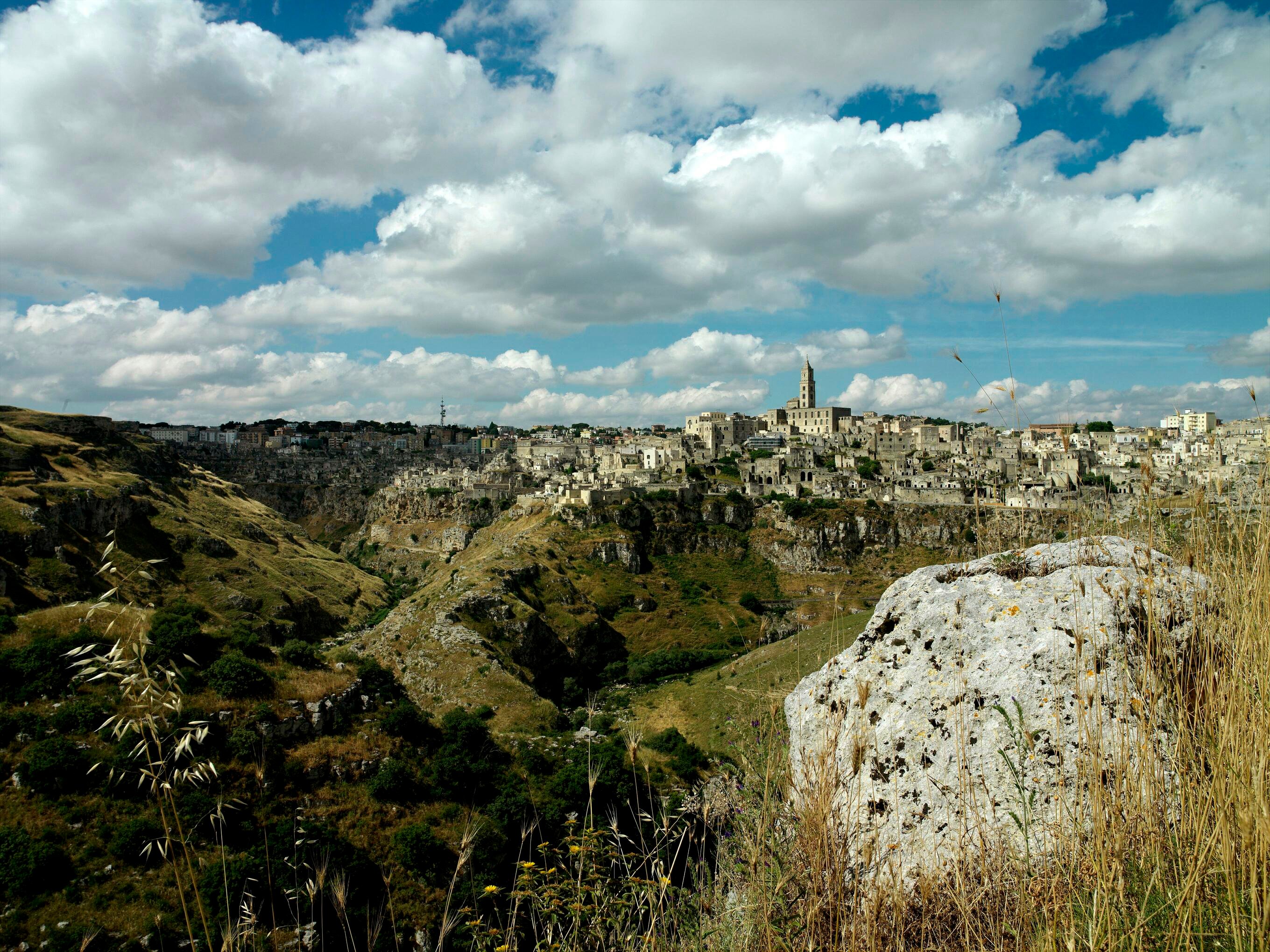
UNESCO added the Sassi of Matera to its list of World Heritage Sites in 1993, as a whole and millennial way of life to be preserved and handed down to our descendants. Matera was the 2019 European Capital of Culture. On one side, it sits on a canyon (ravina in dialect) that can be hiked to enjoy the best views of old Matera.
Visit Matera on our Puglia and Matera Bike Tour.
Stage 11 – Rimini
Rimini in Emilia-Romagna is located along the Riviera del Sole of the Adriatic Sea at the mouth of the Marecchia River, just northeast of Mount Titano and the Republic of San Marino.
The Romans called it Ariminum, and, according to the 1st-century-BC Greek historian Strabo, it originally belonged to the Umbro-Etruscan civilization. The site was occupied in 268 BC by the Romans, and a Latin colony was established there on the boundary of Aemilia and Umbria. As the junction of the great Roman roads the Via Aemilia and the Via Flaminia, it became a Roman municipium (community).
In the 19th century Rimini expanded beyond its walls and became a beach resort, a development accelerated by the establishment of seaside suburbs south of the city after 1920. Despite heavy damage from Allied bombardment in World War II, the city recovered. Its coastal resorts stretch for nearly 10 miles (16 km). Federico Fellini, the movie director, was a Rimini native and that shows in his most iconic movies.
Visit Rimini on our Chef Bike Tour Romagna.
Stage 12 (Nove Colli) – Cesenatico, Forlimpopoli, Bertinoro, Sogliano al Rubicone, and Savignano sul Rubicone
In the picturesque historical center of Cesenatico, which resides somehow harmoniously among modern urban structures, people can still get a sense of the atmosphere of the old fishermen's village. The soft sandy beach with its well-equipped beach centers, and the hinterland, with two big parks, are only a few of the distinctive features of Cesenatico.
The origins of Cesenatico date back to 1302, when the harbor was dug and a fortress was built in order to defend it. In 1502, Leonardo da Vinci redesigned the Canal Harbor, which is still the pride of the town. On August 2, 1849, Garibaldi, with Anita and two hundred followers, sailed from this harbor on fishing boats called "bragozzi" in order to rescue Venice.
The town is really loved by cyclists, thanks to the facilities it offers, the fact that it's home to the biggest and oldest Gran Fondos in Europe (Nove Colli), and is the birthplace of Marco Pantani (there’s a small museum dedicated to him).
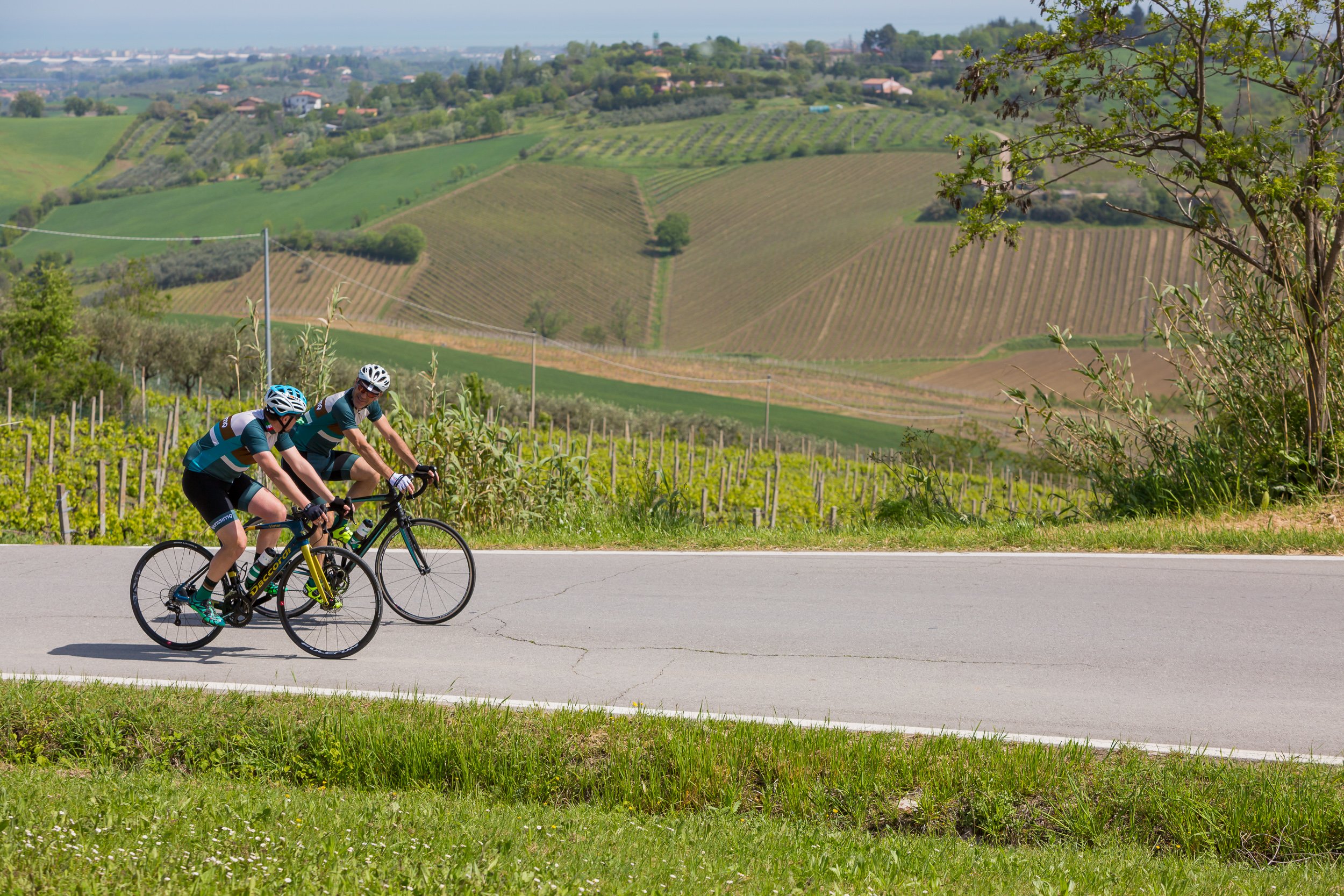
The hills of Romagna where the Nove Colli Gran Fondo takes place
Today, Forlimpopoli is mostly known as the hometown of the gastronome Pellegrino Artusi (Forlimpopoli 1820-Florence 1911); in fact it is also known as Artusiana Town, although it also had an eventful history. Pellegrino Artusi is considered to be the father of modern gastronomy and there’s a museum/restaurant/cooking school named after him for that reason: Casa Artusi.
Bertinoro overlooks a fascinating landscape, where the view goes as far as the sea. Besides its hospitality and the wonderful bird’s-eye view you can enjoy from the main square Piazza della Libertà (it is not by chance that it is called the “Balcony of Romagna”), Bertinoro is a typical example of a Medieval citadel, featuring walls, towers and old houses, and is also known as the “Town of Wine.”
Legend says that Galla Placidia, daughter of the Roman Emperor Theodosius, passed by and tasted a wine served in a poor cup, and she said "non di così rozzo calice sei degno, o vino, ma di berti in oro" (You should not drink this wine in such a poor cup. Rather it should be drunk in a gold goblet). This is where the name of the town comes from.
Sogliano sits quietly on top of the hills of Romagna. The Castle of Sogliano dates back to 1144. The most important monuments are the Church of the Suffragio (1679), the Church of San Lorenzo Martire (1784), the Monastery of the Agostinians (1824), The Fontana delle Farfalle by contemporary artist Tonino Guerra, and the pits where a certain type of cheese is aged (Venturi, Rossini, Pellegrini, Brandinelli and the Pro Loco). The cheese is typical of the area and has a festival dedicated to it in the autumn.
Savignano sul Rubicane lies along the Via Emilia between Cesena and Rimini. Its territory extends to the coast with a small beach resort.
The Roman bridge across the Rubicon River made the area famous throughout the world when Julius Caesar uttered the historical phrase "Alea Iacta Est" (The die has been cast) before marching in the direction of Rome, thereby openly violating the law which forbade armed entry into the confines of the Roman Empire without permission.
Read the Crossing the Rubicon blog.
Visit these sites on one of our Riding Vacations for Cycling Clubs.
Official tourist sites:
I hope you've enjoyed this trip from Sicily to Cesanatico. Here are some useful links and the link to button to out tour lineup where you can actually ride these places:
Giro d’Italia official website:
https://www.giroditalia.it
Official Social Media:
https://www.facebook.com/giroditalia
https://twitter.com/giroditalia
https://www.instagram.com/giroditalia
Be sure to read next week's blog for some of our other favorite places from the 2020 Giro.


